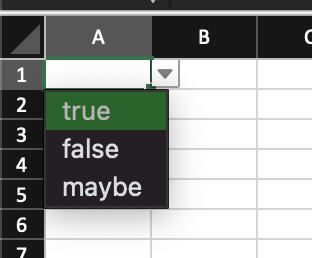Supported Elements¶
The root <html> tag is supported, but optional. One can do any of:
Define html content nested within an
<html>blockDefine top-level
<head>and<body>sibling blocksOmit
<body>entirely (if you have no<head>) and define all markup at the top level.
<head>¶
This block is optional.
Today, any raw content in the head section is essentially a shortcut for
specifying a page <title>.
<title>¶
Any raw content is interpreted as the Excel sheet name.
<body>¶
This block is optional, should you not define a <head> block for setting the
sheet name.
The child elements defined within a body follow a number of different “block” semantics which essentially attempt to mimic the semantics of HTML itself.
At a high level, they boil down to a few different options that we’ll call:
top-level
top-right
bottom-left
bottom-right
The name indicates where the “cursor” will be left after exiting the context of the enclosing block being defined.
For example a <div> (described in the next section) is a bottom-left-type, which means
that after performing the layout for the content of that div, the bounding box defined by the interior
content of the <div> will be calculated and layout for sibling elements after that div
will start at the bottom-left of that bounding box.
+- div -------------------------------------------+
|+- table ---------------------------------------+|
||+- thead -------------------------------------+||
|||+- th ----+-- th -----+-- th -----+ -- th --+|||
|||| example | example 2 | example 3 | example ||||
|||+---------+-----------+-----------+---------+|||
||+---------------------------------------------+||
|| ||
||+- tbody -------------------------------------+||
|||+- tr --------------------------------------+|||
||||+- td ---+-- td ----+-- td ----+ -- td ---+||||
||||| qwertu | abcdefgh | 23456789 | 12345678 |||||
||||+--------+----------+----------+----------+||||
|||| ||||
||||+- td ---+-- td ----+-- td ----+ -- td ---+||||
||||| qwertu | abcdefgh | 23456789 | 12345678 |||||
||||+--------+----------+----------+----------+||||
|||+-------------------------------------------+|||
||+---------------------------------------------+||
|+-----------------------------------------------+|
+-------------------------------------------------+
+- div -------------------------------------------+
+ ... more content ... |
+-------------------------------------------------+
Note, ASCII/graphics will not be a perfect visualization, as it pushes the content to the right as nesting occurs, which will not occur in Excel. However, it should give a sense of where content will start after certain kinds of elements close, and hopefully should give some initial intuition what kind (top-left, bottom-left, top-right) each element might be.
<div>¶
A div is a bottom-left element. Content after a div will resume in the cell directly
below the div’s interior content.
It has no behavior other than the laying out of child elements.
<span>¶
A <span> is a top-right element. Content after a <span> will resume in the cell directly
to the right of the <span>’s interior content.
Generally a <span> will only contain raw text content.
<br>¶
A <br> is a bottom-left element. Content after a <br> will resume in the cell directly
below the <br>. It has no interior content.
<table>¶
A <table> is a bottom-left element. Content after a <table> will resume in the cell directly
below the <table>.
A <table> is essentially a <div>, but for the purpose of defining a visual table
structure.
<thead/tbody>¶
These elements exist primarily to group the table content, but otherwise will not affect layout, relative to the table itself. They are both bottom-left element types.
It can be a convenient markup location to apply styling (which will naturally cascade to the relevant subsections of the table).
<tr>¶
A <tr> is a bottom-left element. Content after a <tr> will resume in the cell directly
below the <tr>.
<th/td>¶
These elements are semantically equivalent to a <span>, but for the purpose of defining
a table’s cell content.
<datalist>¶
A <datalist> element does not get directly rendered into the excel file. As such
a datalist element will not have any effect on the placement of the cursor or layout
of actual DOM elements.
Referencing the documentation on what a datalist does, it will register the set of <option> children as a form of cell validation in the document.
For example:
<datalist id="truthy-values">
<option value="true" />
<option value="false" />
<option value="maybe" />
</datalist>
<input list="truthy-values">
In this case, an excel data validation will be registered and then applied to the cell pointed at by the <input>.
That will then be represented in the excel file like so
